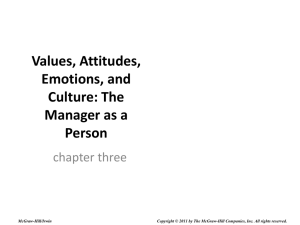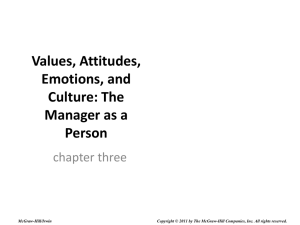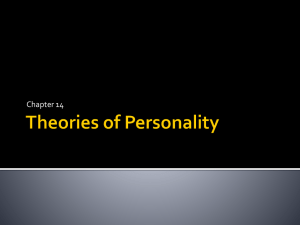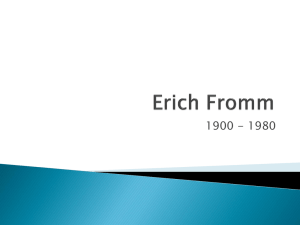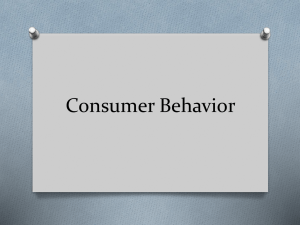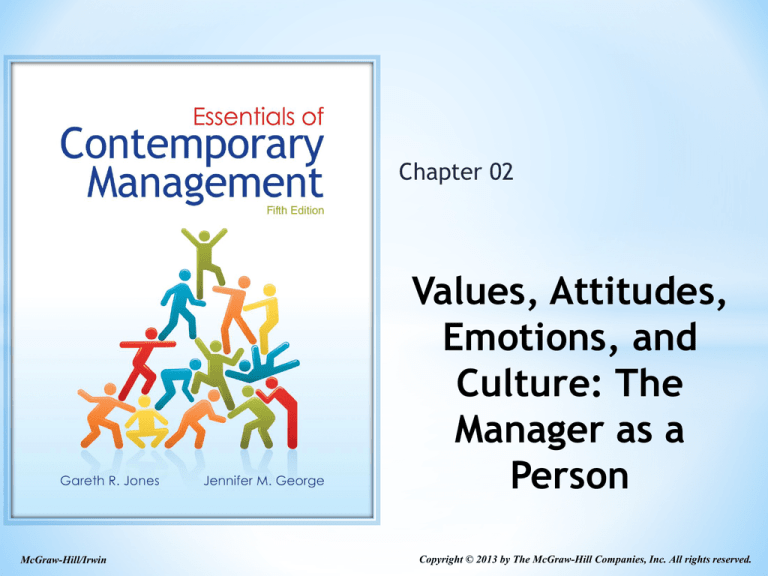
Chapter 02
Values, Attitudes,
Emotions, and
Culture: The
Manager as a
Person
McGraw-Hill/Irwin
Copyright © 2013 by The McGraw-Hill Companies, Inc. All rights reserved.
Learning Objectives
• Describe the various personality traits that affect
how managers think, feel, and behave
• Explain what values and attitudes are and describe
their impact on managerial action
• Appreciate how moods and emotions influence all
members of an organization
• Describe the nature of emotional intelligence and
its role in management
• Define organizational culture and explain how
managers both create and are influenced by
organizational culture
2-2
Enduring Characteristics: Personality Traits
• Personality traits: Enduring tendencies to feel,
think, and act in certain ways that can be used to
describe the personality of every individual
• Managers’ personalities influence their behavior
and approach to managing people and resources
2-3
Manager’s Traits
• No single trait is right or wrong for being an
effective manager
• Effectiveness is determined by a complex
interaction between the characteristics of
managers and the nature of the job and
organization in which they are working
• The Big Five Personality Traits
• a group of five general Traits that contribute to
the composition of an individual’s personality.
• Each should be evaluated
along a continuum.
2-4
Figure 2.1 - The Big Five Personality
Traits
2-5
Big Five Personality Traits
• Extraversion: Tendency to experience positive
emotions and moods and feel good about oneself and
the rest of the world
•
Managers high in extraversion tend to be sociable,
affectionate, outgoing and friendly
•
•
Being high on this trait can be an asset for managers whose
jobs entail an especially high level of social interaction.
Managers low in extraversion tend to be less inclined
toward social interaction and have a less positive
outlook
•
Those low on this factor can be highly effective if excessive
social interaction is not required by their job.
2-6
Big Five Personality Traits
• Negative affectivity: Tendency to experience negative
emotions and moods, feel distressed, and be critical of
oneself and others
• Managers high on this trait may often feel angry and
dissatisfied and complain about their own and others’
lack of progress.
• Managers low on negative affectivity do not tend to
experience many negative emotions and are less
pessimistic and critical of themselves and others
•
•
It is more pleasant to work with a manager who is low
on negative affectivity
Cultivating good working relationships is an important
asset to a manager
2-7
Big Five Personality Traits
• Agreeableness: Tendency to get along well with
others
•
Managers high in agreeableness are likable,
affectionate and care about others
•
Managers with low agreeableness may be
distrustful, unsympathetic, uncooperative and
antagonistic
2-8
Big Five Personality Traits
• Conscientiousness: Tendency to be careful,
scrupulous, and persevering
•
Managers high in this trait are organized and selfdisciplined
•
Managers low in this trait lack direction and selfdiscipline
2-9
Big Five Personality Traits
• Openness to experience: Tendency to be original,
have broad interests, be open to a wide range of
stimuli, be daring and take risks
•
Managers who are high on this trait are likely to
take risks and be innovative in their planning and
decision making
• Managers who are low on this scale tend to be
more conservative in their planning and
decision-making.
2-10
Question?
Which personality trait is a tendency to be careful,
scrupulous, and persevering?
A. Extraversion
B. Agreeableness
C. Conscientiousness
D. Openness to experience
2-11
Figure 2.2 - Measures of Extraversion, Agreeableness,
Conscientiousness, and Openness to Experience
2-12
Figure 2.3 - A Measure of Negative
Affectivity
2-13
Other Personality Traits: Traits that
Affect Managerial Behavior
• Internal locus of control: Tendency to locate
responsibility for one’s fate within oneself
•
Own actions and behaviors are major and decisive
determinants of job outcomes
•
It helps to ensure ethical behavior and decision
making in an organization
• External locus of control: Tendency to locate
responsibility for one’s own fate in outside forces
and to believe that one’s own behavior has little
impact on outcomes
2-14
Other Personality Traits
• External locus of control: Tendency to locate
responsibility for one’s own fate in outside forces
and to believe that one’s own behavior has little
impact on outcomes
2-15
Other Personality Traits
• Self-esteem: Degree to which individuals feel good
about themselves and their capabilities
•
High self-esteem makes a person to feel competent,
deserving, and capable
•
Persons with low self-esteem have poor opinions of
themselves and their abilities
2-16
Other Personality Traits
• Need for achievement: Extent to which an
individual has a strong desire to perform
challenging tasks well and to meet personal
standards for excellence
• Need for affiliation: Extent to which an individual
is concerned about establishing and maintaining
good interpersonal relations, being liked, and
having other people get along
• Need for power: Extent to which an individual
desires to control or influence others
2-17
Values, Attitudes, and Moods and
Emotions
• Values, attitudes, and moods and emotions
capture how managers experience their jobs as
individuals.
• Values: Describe what managers try to achieve
through work and how they think they should behave
• Attitudes: Capture managers’ thoughts and feelings
about their specific jobs and organizations
• Moods and emotions: Encompass how managers
actually feel when they are managing
2-18
Values
• Value system: Terminal and instrumental values
that are guiding principles in an individual’s life
2-19
Values
Terminal values
•
A personal conviction about
lifelong goals or objectives
that an individual seeks to
achieve
•
Terminal values often lead to
the formation of norms which
are informal rules of conduct
for behaviors considered to
be important within an
organization.
Instrumental values
•
Mode of conduct that
an individual seeks to
follow
2-20
Figure 2.4 - Terminal and Instrumental
Values
2-21
Attitudes
• Collection of feelings and beliefs
• Managers have attitudes about their jobs and
organizations, and these attitudes affect how they
approach their jobs.
• Job satisfaction: Collection of feelings and beliefs
that managers have about their current jobs
•
Managers high on job satisfaction like their jobs,
feel that they are being fairly treated, and believe
that their jobs have many desirable features
• Job satisfaction is at record low in U.S.
2-22
Attitudes
• It is desirable for managers to be satisfied with
their jobs for two reasons:
• Satisfies managers are more likely to perform
Organizational citizenship behaviors(OCB)
• Behaviors that are not required of organizational
members but that contribute to and are necessary for
organizational efficiency, effectiveness, and gaining a
competitive advantage
• Less likely to quit.
2-23
Organizational commitment
• Organizational commitment: Collection of
feelings and beliefs that managers have about
their organization as a whole
• With organizational commitment, managers:
• Believe in what their organizations are doing
• Are proud of what the organization stands for
• Feel a high degree of loyalty toward their
organizations.
2-24
Moods and Emotions
• Mood: A mood is a feeling or state of mind.
Personality traits and current circumstances often
determine a person’s mood.
• Emotion:
Emotions are more intense than moods,
are more short-lived, and are usually linked to a
specific cause.
• Moods and emotions give managers and all
employees important information and signals about
what is going on in the workplace
2-25
Emotional Intelligence
• Ability to understand and manage one’s own moods
and emotions and the moods and emotions of other
people
• Managers with high levels of EI are able to
prevent their emotions from getting in the way
of making effective decisions.
• EI helps managers perform the interpersonal
roles of figurehead, leader, and liaison.
• Emotional intelligence helps managers
understand and relate well to other people.
2-26
Question?
What is the ability to understand and manage one’s
own moods and emotions and the moods and
emotions of other people?
A. Emotional intelligence
B. Extraversion
C. Locus of control
D. Machiavellianism
2-27
Figure 2.8 - A Measure of
Emotional Intelligence
2-28
Organizational Culture
• Shared set of beliefs, expectations, values, norms,
and work routines that influence how individuals,
groups, and teams interact with one another and
cooperate to achieve organizational goals
• When organizational members are intensely
committed to a shared system of values, beliefs,
and routines, a strong organizational culture exists
2-29
Organizational Culture
• Attraction-selection-attrition framework: Model
that explains how personality may influence
organizational culture
• Founders hire employees whose personalities are
similar to their own
2-30
Role of Values and Norms in
Organizational Culture
• Terminal values: Signify what an organization and
its employees are trying to accomplish
• Instrumental values: Guide an organization and its
members in achieving organizational goals
• Managers determine and shape organizational
culture through the kinds of values and norms they
promote in an organization i.e. risk-taking,
conservative, etc.
2-31
Figure 2.9 - Factors That Maintain
and Transmit Organizational Culture
2-32
Role of Values and Norms
• Organizational socialization: Process by which
newcomer’s learn an organization’s values and
norms and acquire the work behaviors necessary to
perform jobs effectively
• Ceremonies and rites: Formal events that
recognize incidents of importance to the
organization as a whole and to specific employees
2-33
Ceremonies and Rites
• Ceremonies are formal events that recognize
incidents of importance to the organization as a
whole and to specific employees
• Rites of passage: Determine how individuals enter,
advance within, or leave the organization
• Rites of integration: Build and reinforce common
bonds among organizational members
• Rites of enhancement: Let organizations publicly
recognize and reward employees’ contributions and
thus strengthen their commitment to
organizational values
2-34
Question?
What builds and reinforces common bonds among
organizational members?
A. Rites of passage
B. Rites of integration
C. Rites of enhancement
D. Rites of community
2-35
Table 2.1 - Organizational Rites
2-36
Stories and Language
• Communicate organizational culture
• Reveal behaviors that are valued by the
organization and practices that are frowned on
• Organizational language encompasses how people
dress, the offices they occupy, the cars they drive,
and the degree of formality they use when
addressing one another
2-37

